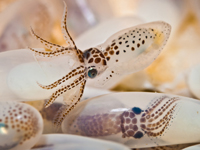

 |

|
 Octopus |
Octopus(Primitive) |
 Octopus Baby |
Octopus HabitsA bottom-dwelling animal, the octopus makes its home in a hole or rock crevice in shallow water. Sometimes it digs a gravel nest or forms a protective area with a pile of rocks.
By day, the octopus spends most of its time hidden in its lair. When it hunts, it propels itself by swimming or crawling along on its tentacles. Its large, lidded eyes are adapted to focus in dim underwater light.
The octopus's predators include moray and conger eels, dolphins and sharks. Whenever possible, the octopus will escape from its predators by shooting a jet of water through its body to create a burst of speed.
Often, however, the octopus avoids detection completely. It can change its body colour and texture so perfectly that it can virtually disappear. The colored pigment in its skin can be concentrated or diluted, forming stripes and patterns that blend into the environment.
The octopus's ink sac also helps it avoid attack. It releases a disorienting black cloud that is accompanied by another secretion to dull the attacker's sense of smell. |
Octopus CommunicationAn octopus's camouflage is aided by certain specialized skin cells which can change the apparent color, opacity, and reflectivity of the epidermis. Chromatophores contain yellow, orange, red, brown, or black pigments; most species have three of these colors, while some have two or four. Other color-changing cells are reflective iridophores, and leucophores (white). This color-changing ability can also be used to communicate with or warn other octopi. The very venomous blue-ringed octopus becomes bright yellow with blue rings when it is provoked. Octopuses can use muscles in the skin to change the texture of their mantle to achieve a greater camouflage. |
Octopus BreedingWhen octopi mate, the male sends waves of spermatophores down one of its arms - the hectocotylus's - into the female to fertilize her eggs. When hatched, the 1/4-inch larva resembles a perfectly formed baby octopus.
For about a week afterward, the female lays clusters of grapelike eggs inside her nest. She will not leave her nest in the month to six weeks that it takes to hatch. Because female octopi do not eat while they are guarding their eggs, it is not uncommon for them to die of starvation.
The eggs hatch into larvae that look like tiny versions of their parents. They come to rest on the seabed, where they mature quickly. |
Octopus Food & FeedingThe octopus does most of its hunting at night. It emerges from its rocky lair to seek crabs, crayfish, and mollusks, which are its favourite foods.
The octopus catches most of its prey by stealth. Having changed colour to blend in with its surroundings, the well-camouflaged octopus waits for prey to pass by and then seizes it with its long arms. The arms are powerful and flexible, with two rows of suckers that help it grip its slippery prey. The octopus then stuns its victim with a secretion of nerve poison. To stalk lobsters and other dangerous prey, the octopus squirts ink into the water to form a screen. Hiding behind the dark cloud, it creeps up on its victim and grabs it from behind.
If the octopus's prey is hard-shelled, the octopus punctures the shell by drilling with its tongue, which is covered in small, sharp teeth. |
Octopus Key Facts |
| Size |
| Height: Length: Up to 10 feet, but usually smaller |
| Weight: Up to 55 lbs. Females are mature at 2 lbs. Males, at 3 1/2 lbs |
| Breeding |
| Sexual maturity: Females, 1 1/2 - 2 years. Males, earlier |
| Mating: Anytime |
| Gestation: Hatching time: 4 - 6 weeks |
| Number of young: Up to 150,000 |
| Lifestyle |
| Habit: Solitary, bottom-dwelling |
| Diet: Mainly crabs, crayfish, and bivalves |
| Lifespan: Females usually die after breeding at about 2 years of age; males live longer |
DID YOU KNOW?
|
CAN'T FIND WHAT YOU'RE LOOKING FOR? CLICK HERE!!!